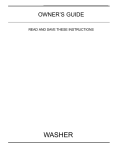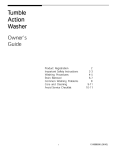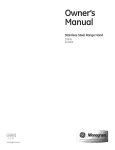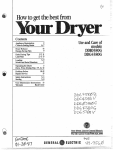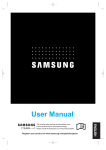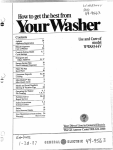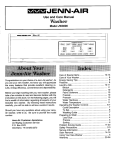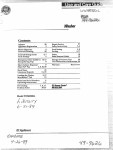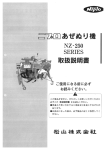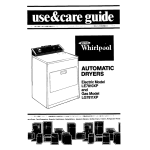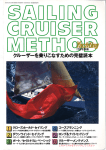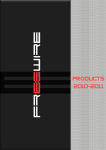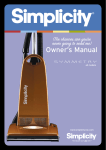Download Frigidaire MET1041ZA Top Load Stacked Washer / Dryer
Transcript
P/N 131585900 (9603) For your safety, the information in this manual must be followed to minimize the risk of fireorexplosionortopreventpropertydamage,personalinjuryorlossoflife. - Donotstoreorusegasolineorotherflammablevaporsandliquidsinthevicinityofthisoranyother appliance. - WHAT TO DO IF YOU SMELL GAS: • Donottrytolightanyappliance. • Do not touch any electrical switch; do not use any phone in your building. • Clear the room, building or area of all occupants. • Immediately call your gas supplier from a neighbor's phone. Follow the gas supplier's instructions. • Ifyoucannotreachyourgassupplier,callthefiredepartment. Installationandservicemustbeperformedbyaqualifiedinstaller,serviceagencyorthegassupplier. Important Safety Instructions Contents ProductRegistration .......... 2 ImportantSafetyInstructions ... 2-3 Washing Procedures ......... 5-7 Stain Removal ............. 7-8 Common Washing Problems .... 9 Drying Procedures .......... 10 Features ................. 11 Common Drying Problems .... 11 Care and Cleaning ......... 12-13 AvoidServiceChecklist ...... 13-15 Warranty and Service ........ 16 Read all instructions before using this laundry center. Toreducetheriskoffire,electricalshock,orinjurytopersonswhen using this laundry center, comply with the basic warningslisted below. Failuretocomplywiththesewarningscouldresultinseriouspersonalinjuries. Prevent Fire Do not wash or dry items that have been previously cleaned in, soaked in, or spotted with gasoline, cleaning solvents, kerosene, cooking oils, waxes,etc.Donotstoretheseitemsonornearthedryer.Thesesubstancesgiveoff vaporsthatcouldigniteorexplode. Do not put oily or greasy rags or clothing on top of the laundry center. These substances give off vapors that could ignite the materials. Product Registration Thank you for choosing this laundry center. This owner's guide willexplainproperoperationandcare. Do not add gasoline, cleaning solvents, or other flammable or explosive substances to the wash water. These substances give off vapors that couldigniteorexplode. Record Your Model and Serial Numbers Under certain conditions, hydrogen gas may be produced in a hot water system that has not been used for 2 weeks or more. HYDROGEN GAS IS EXPLOSIVE. If the hot water system has not been used for such a period, before using the washer, turn on all hot water faucets and let the water flow from each for several minutes. This will release any accumulated hydrogen gas. Hydrogen gas is flammable; do not smoke or use an open flame during this time. Record below the model and serial numbers found on the laundry center serial plate located on the inside of the dryer door. Keep these numbers forfuturereference. Model Number __________________ Topreventfire,donotuseheattodryitemscontainingplastic,foam rubberorsimilarlytexturedrubber-likematerials,oritemscontainingfeathersor down. Use Air Fluff (No Heat) only. Serial Number ___________________ Date of Purchase ________________ Register Your Product The self-addressed PRODUCT REGISTRATION CARD should be filled in completely, signed and returned. Cleanthedryerlintscreenbeforeoraftereachload.Theinteriorof the dryer, lint screen housing and exhaust duct should be cleaned approximately every18monthsbyqualifiedservicepersonnel.Anexcessiveamountoflintbuildupintheseareascouldresultininefficientdryingandpossiblefire.SeeCareand Cleaning Cleaning, pages 12-13. © 1996 White Consolidated Industries, Inc. Allrightsreserved. 2 PrintedinU.S.A. This Owner's Guide provides general operatinginstructionsforyourlaundry center. It also contains information about features for several other models. Your laundry center may not haveeveryfeatureincluded. Use the laundry center only as instructed in this Owner's Guide and the Operating Instructions cards includedwithyourlaundrycenter. Do not operate the dryer if the lint screen is blocked, damaged or missing. Fire hazard, overheating and damage to fabrics can occur. If your dryer has a drying rack, always replace the lint screen when finished using the drying rack. Keep area around the exhaust opening and surrounding areas free from the accumulation of lint, dust and dirt. Do not obstruct the flow of ventilating air. Do not stack or place laundry or throw rugs against the front or back of the laundry center. Do not spray any type of aerosol into, on or near laundry center at anytime. Avoid fire hazard or electricalshock.Donotuseanadaptor plug or extension cord or remove groundingprongfromelectricalpower cord. Failure to follow this warning cancauseseriousinjury,fireordeath. Grounding type wall receptacle Do not under any circumstances cut, remove, or bypass the grounding prong from this plug. Power supply cord with 3-prong grounding plug CORRECT Use this way ONLY Do not use fabric softeners or products to eliminate static unless recommended by the manufacturer of the fabric softener or product. Failuretocomplywiththesewarningscouldresultinfire,explosion,serious bodily injury and/or damage to the rubber or plastic parts of the laundry center. Protect Children Do not allow children to play on or in the laundry center. Close supervisionofchildrenisnecessarywhenthelaundrycenterisusednearchildren. As children grow, teach them the proper, safe use of all appliances. Destroythecarton,plasticbagandotherpackingmaterialsafterthe laundry center is unpacked. Children might use them for play. Cartons covered with rugs, bedspreads or plastic sheets can become airtight chambers. Keep laundry products out of children's reach. To prevent personal injury,observeallwarningsonproductlabels. Before the laundry center is removed from service or discarded, remove the washer lid and dryer door to prevent accidental entrapment. Failuretocomplywiththesewarningscouldresultinseriouspersonalinjuries. Note: The instructions appearing in this Owner's Guide are not meant to cover every possible condition and situation that may occur. Common sense and caution must be practiced when installing, operating and maintaininganyappliance. Prevent Injury To prevent shock hazard and assure stability during operation, the laundry center must be installed and electrically grounded by a qualified service personinaccordancewithlocalcodes.Installationinstructionsarepackedinthe laundrycenterfortheinstaller'sreference.RefertoINSTALLATIONINSTRUCTIONS fordetailedgroundingprocedures.Ifthelaundrycenterismovedtoanewlocation, haveitcheckedandreinstalledbyaqualifiedserviceperson. 3 Important Safety Instructions (continued) Do not use or mix liquid chlorine bleach with other household chemicals such as toilet cleaners, rust removers, acid or products containing ammonia. These mixtures can produce dangerous fumes which can cause serious injury or death. an adaptor plug. Follow package directions when using laundry products. Incorrect usage can produce poisonous gas--resulting in serious injury or death. • Do not combine laundry products for use in 1 load unless specified on the label. • Do not mix chlorine bleach with ammonia or acids such as vinegar. To prevent serious personal injury and damage to the laundry center: • All repairs and servicing must be performed by an authorized servicer unless specifically recommended in this Owner's Guide. Use only authorized factoryparts. • Do not tamper with controls. • Do not install or store the laundry center where it will be exposed to the weather. ALWAYS disconnect the laundry center from the electrical supply beforeattemptinganyserviceorcleaning.Failuretodosocanresultinelectrical shockorinjury. To prevent injury, do not reach into the washer while parts are moving. Beforeloading,unloadingoraddingitems,pushinthecycleselectorknob and allow the tub to coast to a complete stop before reaching inside. Topreventinjury,donotreachintothedryerifthedrumismoving. Wait until the dryer has stopped completely before reaching into the drum. Do not use any type spray cleanser when cleaning dryer interior. Hazardous fumes or electrical shock could occur. Athermallimiterswitchautomaticallyturnsoffthedryermotorintheunlikely eventofanoverheatedsituation(electricdryersonly).Aservicetechnicianmust replacethethermallimiterswitchaftercorrectingthefault. The washer is equipped with an electrical overload protector. The motor will stop if it becomes overheated. The washer will automatically restart after a cool down period of up to 30 minutes, if the washer has not been manually turned off duringthistime. Failuretocomplywiththesewarningscouldresultinseriouspersonalinjuries. SAVE THESE INSTRUCTIONS 4 Washing Procedures • Follow the guidelines below for preparing the wash load. • Read the Washer Operating Instructions card for operating your specific model. • Always read and follow fabric care and laundry product labels. Toreducetheriskoffire,electricalshock,orinjurytopersons,read Important Safety Instructions Instructions, pages 2-4, before operating this washer. 1. Sort laundry into loads that can be washed together. Sort laundry into loads that can be washed together. Sort items by recommended water temperatures, wash time, and agitate/spin speeds. • Separate white, light, and colorfast items from dark and noncolorfast items. • Separate items which shed lint from items which attract lint. Permanent press,synthetic,knitandcorduroyitemswillpickuplintfromtowels,rugs andchenillebedspreads. • Separateheavilysoileditemsfromlightlysoileditems. • Separatelacy,sheerandlooselyknititemsfromsturdyitems. 2. Prepare items for washing. • • • • • • Empty pockets. • Empty pockets. Brush off lint and dirt. Shake out rugs and beach towels. Closezippers,fastenhooks,tiestringsandsashes,andremovenonwashable trims and ornaments. Remove pins, decorative buttons, belt buckles, and other objects which could be damaged. This also helps protect other items in the wash load. Mend rips and tears to prevent further damage during washing. Place delicate items such as bras, shoulder pads, hosiery, and belts in a mesh bag to prevent tangling during the wash cycle. Turnknititemsinsideouttopreventpilling. 3. Pretreat stains and heavy soil. See Stain Removal Removal, pages 7-8, for details. 4. Add a measured amount of detergent to the wash tub before adding the laundry load. Follow detergent manufacturer's directions. The amount required depends on typeofdetergent,loadsizeandsoillevel,andwaterhardness. Place delicate items in a mesh bag. 5. If desired, add liquid bleach to Bleach Dispenser (some models). • Beforeaddingthewashload,addliquidbleachtobleachdispenserlocated inleftfrontcornerunderthelid: • 3/4 cup (180 ml) for small loads • 1 cup (240 ml) for large loads • 1-1/4cups(300ml)forextra-largeloads. Bleach Dispenser (some models) • Then add 1 cup (240 ml) water to flush the dispenser. • Do not use powdered bleach in the bleach dispenser. For models without a bleach dispenser, dilute the recommended amount of liquid chlorine bleach in 1 quart (.95 L) water. Add it to wash water after a few minutes of agitation. Do not pour bleach directly on wash load. 5 Washing Procedures (continued) Do not use liquid chlorine bleach with other household chemicals. 6. Add laundry load to washer. • Dry load level should not be higher than top row of holes in wash tub. Do not overload washer. • Do not put items on top of agitator or wrap them around it. Load items evenly. • Combinelargeandsmallitemsinaload.Loadlargeitemsfirst. Largeitems should not be more than half the total wash load. • When washing a single heavy item, add 1 or 2 towels to balance the load. 7. If desired, add liquid fabric softener to Fabric Softener Dispenser (some models). For models with a built-in dispenser (see picture below to the left): 1. Add liquid softener to the dispenser, following fabric softener label directions. 2. Addwatertobringliquidleveltofilllineondispensercap. 3. Remove the dispenser from the agitator after each use. Rinse both cap and cup with warm water. Replace dispenser in the agitator. IMPORTANT: Do not stop and restart washer during a spin when using the fabricsoftenerdispenser. Do not load items above top row of holes in wash tub. For models with a removable dispenser (see picture below to the left): 1. Attachfabricsoftenerdispensertotopofagitatorbypressingdowngently. 2. Addsoftenertothedispenser,followingfabricsoftenerlabeldirections. 3. Add water to bring liquid level to top of the peg in the center of the cup. 4. Remove the dispenser from the agitator after each use. Rinse both lid and bowl thoroughly with warm water. Reassemble and place dispenser on agitatororstoreitnearby. IMPORTANT: Do not stop and restart washer during a spin when using the fabricsoftenerdispenser. For models without a fabric softener dispenser, follow fabric softener label directions. Add diluted fabric softener to the final rinse.Do not pour fabric softener directly on the wash load. Built-InFabricSoftenerDispenser (some models) 8. Set cycle selector knob and washer controls according to type, size, and soil level of each load, and detergent used. See Washer Operating Instructions card for your specific model controls. Removable Fabric Softener Dispenser (some models) 6 9. Start the washer. Close the washer lid and pull out the cycle selector knob. Washer will fill and agitatewiththelidopen.Thetubwillnotspinunlessthelidisclosed. • To stop the washer, push in the cycle selector knob. • Tochangeacycle,pushinthecycleselectorknob.Turnitclockwisetothe desiredsetting.Pullouttheknobtorestartthewasher. 10. Remove items when the cycle is completed. Foryoursafety,thelidlockswhenthetubisspinning.Itwillremainlockedfor about 1 minute after the tub stops spinning. • Toopenthelidduringaspin,pushinthecycleselectorknobandwaitabout 1 minute for the lid lock to release. Do not force open the locked lid. Placewasheditemsinautomaticdryer,linedry,ordryflatasdirectedbyfabric carelabel.Excesswrinkling,colortransferorodorsmaydevelopinitemsleftin the washer after the cycle has ended. Stain Removal Safe Stain Removal Procedures Toreducetheriskoffireorseriousinjurytopersonsorproperty, comply with the basic warnings listed below: • Read and comply with all instructions on stain removal products. • Keep products in their original labeled containers and out of children's reach. • Thoroughly wash any utensil used. • Do not combine stain removal products, especially ammonia and chlorine bleach. Dangerous fumes may result. • Never wash items which have been previously cleaned in, washed in, soaked in or spotted with gasoline, dry cleaning solvents or other flammable or explosive substances because they give off vapors that could ignite or explode. • Never use highly flammable solvents, such as gasoline, inside the home. Vapors can explode on contact with flames or sparks. Do not combine stain removal products. For successful stain removal: • Remove stains promptly. Followfabriccarelabelinstructions. • Determine the kind of stain, then follow recommended treatment in the stain removal chart on the next page. • To pretreat stains, use a prewash product, liquid detergent, or a paste made from granular detergent and water. • Use cold water on unknown stains because hot water can set stains. • Check care label instructions for treatments to avoid on specific fabrics. • Check for colorfastness by testing stain remover on an inside seam. • Rinse and wash items after stain removal. 7 Stain Removal STAIN TREATMENT Adhesive tape, chewing gum, rubber cement Apply ice. Scrape off excess. Place stain face down on paper towels. Saturate with prewash stain remover or nonflammabledrycleaningfluid. Babyformula,dairyproducts, egg Use product containing enzymes to pretreat or soak stains. Soak for 30 minutes or more. Wash. Beverages(coffee,tea,soda, juice,alcoholicbeverages) Pretreatstain.Washusingcoldwaterandbleachsafeforfabric. Blood Rinse with cold water. Rub with bar soap. Or, pretreat or soak with product containing enzymes. Wash using bleach safeforfabric. Candle wax, crayon Scrape off surface wax. Place stain face down between paper towels. Press with warm iron until wax is absorbed. Replace paper towels frequently. Treat remaining stain with prewash stain remover or nonflammable dry cleaning fluid. Hand wash to remove solvent. Wash using bleach safe for fabric. Chocolate Pretreat or soak in warm water using product containing enzymes. Wash using bleach safe for fabric. Collarorcuffsoil,cosmetics Pretreat with prewash stain remover or rub with bar soap. Dyetransferonwhitefabric Use packaged color remover. Wash using bleach safe for fabric. Grass Pretreat or soak in warm water using product containing enzymes. Wash using bleach safe for fabric. Grease,oil,tar(butter,fats, saladdressing,cookingoils, cargrease,motoroils) Scraperesiduefromfabric.Pretreat.Washusinghottestwatersafeforfabric.Forheavystainsandtar,apply nonflammable drycleaning fluidtobackofstain.Replacetowelsunderstainfrequently. Rinsethoroughly. Washusing hottestwatersafeforfabric. Ink Some inks may be impossible to remove. Washing may set some inks. Use prewash stain remover, denatured alcohol ornonflammabledrycleaningfluid. Mildew, scorch Wash with chlorine bleach if safe for fabric. Or, soak in oxygen bleach and hot water before washing. Badly mildewed fabrics may be permanently damaged. Mud Brush off dry mud. Pretreat or soak with product containing enzymes. Mustard, tomato Pretreatwith prewashstainremover.Wash usingbleachsafe for fabric. Nailpolish May be impossible to remove. Place stain face down on paper towels. Apply nail polish remover to back of stain. Repeat,replacingpapertowelsfrequently.Donotuseonacetatefabrics. Paint,varnish WATER BASED: Rinse fabric in cool water while stain is wet. Wash. Once paint is dry, it cannot be removed. OIL BASED AND VARNISH: Use solvent recommended on can label. Rinse thoroughly before washing. Perspiration Use prewash stain remover or rub with bar soap. Rinse. Wash using nonchlorine bleach in hottest water safe for fabric. Rust, brown or yellow discoloration Forspots,userustremoversafeforfabric.Fordiscolorationofanentireload,usephosphatedetergentand nonchlorine bleach. Do not use chlorine bleach because it may intensify discoloration. Shoepolish LIQUID: Pretreat with a paste of granular detergent and water. PASTE: Scrape residue from fabric. Pretreat with prewash stain remover or nonflammable dry cleaning fluid. Rinse. Rub detergent into dampened area. Wash using bleachsafeforfabric. Urine,vomit,mucus,feces Pretreat or soak in product containing enzymes. Wash using bleach safe for fabric. 8 Common Washing Problems Many washing problems involve poor soil and stain removal, residues of lint and scum, and fabric damage. For satisfactory washing results, follow these suggestions provided by The Soap and Detergent Association. PROBLEM POSSIBLE CAUSES SOLUTIONS PREVENTIVE MEASURES Blue stains •Detergentorliquidfabricsoftener didnotdissolveordisperse. •If caused by detergent, mix 1 cup (240 ml) white vinegar with 1 quart (.95 L) water in a plasticcontainer.Soakitem1hour.Rinse. •Ifcausedbyfabricsoftener,rubstainswith bar soap. Wash. •Add detergent before wash load. Then start washer. •Dilutefabricsoftenerwithwater. Discoloration, graying •Not enough detergent. •Wash water temperature too low. •Incorrectsorting. •Rewash with correct amount of detergent andhottestwatersafeforfabric.Add bleachsafeforfabric. •Sortitemsbysoillevelandcolor. •Use correct amount of detergent, hottest waterandbleachsafeforfabric. Greasy,oilystains •Not enough detergent. •Undilutedliquidfabricsoftener poureddirectlyonfabric. •Treatwithprewashstainremoveror liquid detergent. •Increase detergent and water temperature. Rewash. •Rubfabricsoftenerstainswithbarsoap. •Use correct amount of detergent and hottestwatersafeforfabric. •Do Do not pour liquid fabric softener directlyonfabric. Seepackagedirections or Washing Procedures for proper diluting. Holes,tears,or snags •Incorrectuseofchlorinebleach. •Unfastenedzippers,hooks,buckles. •Rips,tearsandbrokenthreads. •Overloading the washer. •Degradationoffabric. •Maybeirreversibleifrips,tearsandseams cannot be mended. •Neverpourchlorinebleachdirectlyonfabric. •Check condition of items before washing. See Washing Procedures for preparing and loading the wash load. Lint •Incorrectsorting. •Tissuesleftinpocket. •Overloading the washer. •Not enough detergent. •Undissolveddetergenthasleft residue. •Staticclingisattractinglint. •Load washed too long. •Reduce load size. Rewash using correct water temperature, water level, and amount of detergent. •Add nonprecipitatingwaterconditionerto wash water. • Addliquidfabricsoftenertofinalrinse. •Dryloadindryer. •Removelintwithlintbrushorroller. •See Washing Procedures for sorting and preparing the wash load. •Do not overload washer. •Use correct amount of detergent, water temperature and water level. Pilling (Fibersbreakoff,ball upandclingtofabric) •Pillingisnormalwithsyntheticand permanentpressfabrics.Thisisdue to abrasion from normal wear. •Usealintbrushorshavertoremovepills. •Usefabricsoftenerinthewashertolubricate fibers. •Whenironing,usespraystarchorfabric finishoncollars andcuffs. •Turnitemsinsideouttoreduceabrasion. Residue or powder on dark items; Stiff,harshfabrics. •Undissolveddetergent. •Some nonphosphate granular detergents can combine with hard water minerals to form a residue. •Reduceloadsize. •Add dissolved detergent to tub . Rewash load. •Mix 1 cup (240 ml) white vinegar to 1 gallon (3.8L)warmwaterinplasticcontainer. Soak item. Rinse and rewash. •Increasewatertemperatureusinghottest watersafeforfabric. •Do not overload washer. •Useliquiddetergentorusenonprecipitating water conditioner with nonphosphate granulardetergent. Wrinkling •Overloading the washer. •Reduceloadsize. •Rinseincoldwaterwithliquidfabric softener. •Do not overload washer. •Remove items from washer as soon as cycle iscompleted. •Useliquidfabricsoftener. Yellow buildup of body soil on syntheticfabrics •Agitationtimetooshort. •Wash water temperature too low. •Not enough detergent. •Soak in detergent booster or product containingenzymes. •Wash in hot water (120°F/49°C) using full permanentpresscycle.Increasedetergent. Addbleachsafeforfabric. •Or,treatwithcolorremover. •Washsynthetics frequently usingwaterat least100°F(37°C)andcorrectwaterlevel. Yellow or brown ruststains •Iron or manganese in water supply, waterpipes,orwaterheater. •Torestorediscoloredloadofwhites,use rustremoversafeforfabric. Do not use chlorine bleach to remove rust stains. It may intensify discoloration. •Usenonprecipitatingwatersoftener. •Before washing, run hot water for a few minutestoclearlines. •Drainwaterheateroccasionally. •Foranongoingproblem,installanironfilter inyourwatersupplysystem. 9 Drying Procedures • Follow the guidelines below for preparing the load for drying. • Read the Dryer Operating Instructions card for operating your specific model. • Always read and follow fabric care labels and laundry product labels. Toreducetheriskoffire,electricalshock,orinjurytopersons,read Important Safety Instructions Instructions, pages 2-4, before operating this dryer. 1. Prepare items for drying. Followfabriccarelabelinstructions. • Dry items of similar fabric, weight and construction in the same load. • Separatedarkitemsfromlight-coloreditems.Separateitemsthatshedlint fromthosethatattractlint.Ifanitemshedslint,turnitinsideout. • Be sure buckles, buttons and trim are heatproof and won't damage the drumfinish.Closezippers,fastenhooksandVelcro®-likefasteners.Tie strings and sashes to prevent snagging and tangling. • Ifpossible,turnpocketsinsideoutforevendrying. • Check for stains which may not have been removed in washing. Dryer heat may permanently set some stains. Repeat stain removal process before drying. • Place small items in a mesh bag to prevent tangling and for easy removal. 2. Check that lint screen is clean and in place. 3. Load the dryer. • Theaverageloadwillfillthedrum1/3to1/2full.Itemsneedroomtotumble freely for even drying and less wrinkling. Do not overload dryer. • Whendryinglargeitems,dryonly2or3atatime.Fillouttheloadwithsmall and medium sized items. • Fordelicateorverysmallloads,add2lint-freetowelsforbetterdrying,less wrinkling,andtopreventgreasestainscausedbyfabricsoftenersheets. • Donotoverdryitems.Overdryingcancausewrinkling,shrinkage,harshness, andabuild-upofstaticelectricity,whichcanproducemorelint. • Ifdesired,addadryerfabricsoftenersheet. Place small items in a mesh bag. 4. Close the dryer door and set dryer controls (some models). See Dryer Operating Instructions card for your specific model controls. 5. Turn cycle selector clockwise to the desired setting. 6. Start the dryer. Filldryerdrum1/3to1/2full. • Push Start button for 2 seconds. • To add or remove items when the dryer is running, open the door. The dryer will always stop when the door is opened. Allow the drum to come to a completestopbeforereachinginside. • Torestartdryer,closethedoorthenpushStartbutton.Holdfor1-2seconds andrelease. 7. When the cycle ends, remove items immediately and hang orfold.Ifloadisremovedbeforethecycleends,turncycleselectortoOFF. 10 Features Cycle Signal Control (some models) When the Cycle Signal Control is ON, a signal will sound at the end of each cycle and during the Press Saver setting (some models).The volume is adjustableon some models. Drum Light (some models) A drum light will come on whenever the door is opened to illuminate the dryer drum during loading and unloading.Closing the door turns off the light. Drying Rack (some models) Use the drying rack to dry items which should not be tumble dried. 1. Open the dryer door and remove the lint screen. 2. Insertdryingrackintothedryerdrum.Placethefrontbarunderthelipofthe lint screen opening. The side bars should sit in the notches of the frame. 3. Place items to be dried on top of rack. Weight should not exceed 10 lbs. Leave space between items, but do not let items hang over the sides or through the grids. Do not tumble other items when using the drying rack. 4. Selectatimeddrysettingbestsuitedforitemsbeingdried.UseonlytheAirFluff (no heat) temperature setting for items containing plastic, foam rubber, rubber-likematerials,feathersordown. Use the drying rack to dry items which should not be tumbled. 5. When items aredry, remove therack andreplace thelint screen. Iflint screen is not in place, tumbling items could enter the exhaust system and cause damage to the dryer. Common Drying Problems Many drying problems involve poor cleaning results, poor soil and stain removal, residues of lint and scum, and fabric damage. Forsatisfactorydryingresults,followthesesuggestionsprovidedbyTheSoapandDetergentAssociation. POSSIBLE CAUSES SOLUTIONS PREVENTIVE MEASURES Greasy,oily stains •Fabricsoftenersheet. •Rubfabricsoftenerstainswithbarsoap. Rinse and rewash. •Add a few bath towels to small loads for proper tumbling. •Some"silk-like"fabricsshouldbeairdried. •Use proper drying temperature. •Placefabricsoftenersheetontopofloadbefore startingthedryer. Lint •Overloading. •Overdryingcausesstatic electricity. •Lint screen not clean when cyclebegan. •Lintisattachedto"pills." •Reduce load size and rewash using liquid fabricsoftenerinthefinalrinse. •Or, add a fabric softener sheet and tumble without heat. •Uselintbrushorrollertoremovelint. •Do not overloaddryer. •Use fabric softener in washer or dryer to reduce staticelectricity. •Remove items when they are slightly damp to avoidoverdrying. •Checkthatlintscreeniscleanandinplace. Pilling (Fibersbreakoff, ballupandcling tofabric.) •Pillingisnormalwithsynthetic andpermanentpressfabrics. Thisisduetoabrasionfrom normal wear. •Usealintbrushorshavertoremovepills. •Usefabricsoftenertolubricatefibers. •Whenironing,usespraystarchorfabricfinishon collars andcuffs. •Turnitemsinsideouttoreduceabrasion. Shrinking •Overdrying. •Irreversiblecondition. •Followfabriccarelabeldirections. •Ifshrinkingisaconcern,checkloadoften. •Remove items while slightly damp. •Blockknitsintoshape. •Layflattocompletedrying. Wrinkling •Overloading. •Leavingitemsindryerafter cycleends. •Reduce load size and tumble at medium or low heat for 5-10 minutes. •Remove items immediately. Hang or fold. •Do not overloaddryer. •Remove items as soon as cycle ends. PROBLEM 11 Care and Cleaning Toreduceriskoffireorseriousinjurytopersonsorproperty,comply with the basic warnings listed in Important Safety Instructions Instructions, pages 2-4, and thoselistedbelow. • Before cleaning the washer or dryer interior, unplug the electrical power cord toavoidelectricalshockhazards. • Do not use any type spray cleanser when cleaning dryer interior. Hazardous fumesorelectricalshockcouldoccur. Inside the Washer • Remove items from the washer as soon as the cycle ends. Excess wrinkling, color transfer, and odors may develop in items left in the washer. • Dry the washer top, the area around the lid opening, and the underside of the lid.Theseareasshouldalwaysbedrybeforethelidisclosed. • Before cleaning the washer interior, unplug the electrical power cord to avoidelectricalshockhazards. • When extremely soiled items have been washed, a dirty residue may remain on the tub. Remove this by wiping the tub with a nonabrasive household cleanser. Rinse thoroughly with water. • The agitator or tub may become stained from fabric dye. Clean these parts with anonabrasivehouseholdcleanser.Thispreventsdyetransfertofutureloads. Cleanlintscreenaftereveryload. Washlintscreenoccasionally. Use care with laundry products. They can damage finish on thelaundrycenter. Inside the Dryer • Cleanthedryerlintscreenaftereveryload.Lintbuild-upinthescreenrestricts airflow,whichcauseslongerdryingtimes.Thescreenislocatedatthebottom ofthedooropening.Removebypullingstraightup.Removethelintandreplace thescreen. • Occasionally a waxy build-up may form on the lint screen from using dryeraddedfabricsoftenersheets.Toremovethisbuild-up,washthelintscreenin warm, soapy water. Dry thoroughly and replace. Do not operate the dryer withoutthelintscreeninplace. • If the dryer drum becomes stained from noncolorfast fabrics, clean the drum with a damp cloth and a mild liquid household cleanser. Remove cleanser residuebeforedryingthenextload. • Every18monthsanauthorizedservicershouldcleanthedryercabinetinterior andexhaustduct.Theseareascancollectlintanddustovertime.Anexcessive amountoflintbuild-upcouldresultininefficientdryingandpossiblefirehazard. Outside • When laundering is completed, wipe cabinet with a damp cloth. Turn water faucetsofftopreventpressurebuild-upinthehoses. • Clean the cabinet with mild soap and water. Never use harsh, gritty or abrasivecleansers. Iftoporlidbecomesstained,cleanwithdilutedchlorine bleach[1/2cup(120ml)in1quart(.95L)water].Rinseseveraltimeswithclear water. • Remove glue residue from tape or labels with a mixture of warm water and mild detergent.Or,touchresiduewiththestickysideofthetapeorlabel. • Before moving the laundry center, place a strip of cardboard or thin fiberboard under the front leveling legs to prevent floor damage. 12 Winterizing Instructions Follow Winterizing Instructions for cold weather care. If the laundry center is stored in an area where freezing can occur or moved in freezingtemperatures,followthesewinterizinginstructionstopreventdamageto thelaundrycenter: 1. 2. 3. 4. 5. 6. 7. 8. Turnoffwatersupplyfaucets. Disconnect hoses from water supply and drain water from hoses. Plugelectricalcordintoaproperlygroundedelectricaloutlet. Add 1 gallon nontoxic recreational vehicle (RV) antifreeze to empty wash tub. Closelid. Setcycleselectorknobataspinsetting.Pulloutknobandletwasherspinfor 1 minute to drain out all water. Not all of the RV antifreeze will be expelled. Pushinknob,unplugelectricalpowercord,drytubinterior,andcloselid. Storewasherinanuprightposition. To remove antifreeze from washer after storage, run empty washer through a complete cycle using detergent. Do not add wash load. Avoid Service Checklist Before calling for service, review this list. It may save both time and expense. The list includes common concerns that are not theresultofdefectiveworkmanshipormaterialsinthislaundrycenter. POSSIBLE CAUSE SOLUTION "Clunking" or gear sounds. A certain amount of "clunking" or gear soundsarenormalinaheavy-dutywasher. Thisisnormal. Rattling and clanking noise. Foreign objects such as coins or safety pins may be in tub or pump. Stop washer and check tub. If noise continues after washer is restarted, objects may be in pump. Call your authorizedservicer. Beltbucklesandmetalfastenersarehitting wash tub. To prevent unnecessary noise and damage to tub, fasten fastenersandturnitemsinsideout. Squealing sound or hot rubber odor. Washer is overloaded. Do not overload washer. Stop washer and reduce load. Thumping sound. Heavy wash loads may produce a thumping sound. Thisisusuallynormal.Ifsoundcontinues,washerisprobably outofbalance.Stopwasherandredistribute washload. Vibrating noise. Laundry center is not resting on a solid, firmfloor. Movelaundrycentersoitrestsfirmlyonsolidfloor.Additional floor bracing may be needed. Adjust leveling legs. See INSTALLATION INSTRUCTIONS for details. Shipping bolt and block have not been removedduringinstallation. See INSTALLATION INSTRUCTIONS for removing shipping boltandblock. Wash load unevenly distributed in tub. Stop washer and rearrange wash load. Electrical power cord may not be plugged in or connection may be loose. Makesureplugfitstightlyinwalloutlet. Housefuseblown,circuitbreakertripped, or a power outage has occurred. Resetcircuitbreakerorreplacefuse.Donotincreasefuse capacity.Ifproblemisacircuitoverload,haveitcorrected byaqualifiedelectrician. Ifproblemisapoweroutage, calllocalelectriccompany. Water supply faucets are not turned on. Turn on water supply faucets. OCCURRENCE WASHER - NOISE WASHER - OPERATING Washer does not start. 13 OCCURRENCE POSSIBLE CAUSE SOLUTION Cycleselectorisnotincorrectposition. Moveindicatorclockwiseslightly.Pulloutknob. Motor is overheated. Washermotorwillstopifitbecomesoverheated.Itwill automaticallyrestartafteracooldownperiodofupto 30 minutes (if washer has not been manually turned off). Washer won't spin. Lidisnotcompletelyclosed. Closelidcompletely. Residue left in tub. Heavilysoileditems. Wipe tub with a nonabrasive household cleanser, then rinse. Shake or brush excess dirt and sand from items before washing. Washer is overloaded. Do not overload washer. See Washing Procedures. Load is out of balance. Rearrange load to allow proper spinning. Drainhoseiskinked. Straightendrainhose. Water supply is not adequate in area. Check another faucet in the house. Wait until water supplyandpressureincrease. WASHER - OPERATING (continued) Washer does not start (continued). WASHER - WATER Wash load too wet after spin. Water does not enter washer or it enters slowly. Watersupplyfaucetsarenotcompletelyopen. Fully open hot and cold faucets. Water is being used elsewhere in the house. Water pressure must be at least 30 psi (260 kPa).Avoid runningwaterelsewherewhilewasherisfilling. Water inlet hoses are kinked. Straightenhoses. Improperwaterlevelselection(for modelswithwaterlevel/loadsizecontrol). Selecthigherwaterlevel/loadsize. Washer is overloaded. Do not overload washer. When control is setat highest filllevel,dryloadlevelshouldnotbehigherthantop row of circular holes in wash tub. Hot water heater is set too low or is a distancefromlaundrycenter. Measure hot water temperature at nearby faucet with candy or meat thermometer. Water temperature should be at least 130°F (70°C). Adjust water heater as necessary. Hot water is being used elsewhere in the house. Avoid using hot water elsewhere before or during washer use. There may not be enough hot water availableforpropercleaning.Ifproblempersists,your hot water system may be unable to support more than 1 use at a time. Water in washer does not drain or drains slowly. Drain hose is kinked or clogged. Clean and straighten the drain hose. Water leaks. Fillhoseconnectionatfaucetorwasher. Check and tighten hose connections. Install rubber sealingwashersprovided. House drain pipes are clogged. Unclog drain pipes. Contact plumber if necessary. Oversudsing. Uselessdetergent. Incorrect wash and rinse temperatures. Hot and cold water hoses are connected to wrong supply faucets. Connect hot water hose to hot water faucet and cold water hose to cold water faucet. Water is entering washer but tub does not fill. Drainhosestandpipeisincorrectheight. Standpipe must be a minimum of 33" (83.82 cm) high to prevent siphoning. See INSTALLATION INSTRUCTIONS. Water level does not cover load. Warm or hot water is not hot enough. 14 OCCURRENCE POSSIBLE CAUSE SOLUTION Electricalpowercordisnotsecurelyplugged in or plug may be loose. Makesuretheplugfitstightlyinwalloutlet. Housefuseblownorcircuitbreakertripped. Resetcircuitbreakerorreplacefuse. DRYER Dryer does not start. Makesureelectricallineisnotoverloadedandthedryer isonaseparatecircuit. Dryer runs but won't heat. Drying cycle takes too long, outside of the dryer feels too hot or smells hot. Thermallimitertripped. Callauthorizedservicepersonforreplacement. Thereare2housefusesinthedryercircuit. If 1 of the 2 fuses is blown, the drum may turnbuttheheaterwillnotoperate. Replacefuse. Gas supply valve is not open (gas models). Check to make sure supply valve is open. See INSTALLATION INSTRUCTIONS for procedure. Dryer does not have enough air supply to support the burner flame (gas models). See INSTALLATION INSTRUCTIONS. LP gas supply tank is empty or there has beenautilityinterruptionofnaturalgas (gasmodels). Refillorreplacetank. Lintscreeniscloggedwithlint. Make sure all lint has been removed from the dryer lint screenbeforestartingeachcycle. Exhaust duct requirements have not been met. Exhaust duct must be at least 4 inches in diameter and madeofrigidorflexiblemetal. Dryershouldheatwhenutilityserviceisrestored. When in place, the duct must have no more than two 90° bends and must not exceed length listed in INSTALLATION INSTRUCTIONS. Excessive wrinkling. Electric dryer is connected to a 208 volt circuit. Drying time will be 20% longer than drying on a 240 volt circuit. Dryingprocedureshavenotbeenfollowed. See Drying Procedures Procedures, page 10. Outside exhaust hood or exhaust duct may becloggedorrestricted. Clean out any obstruction. Highhumidity. Use a dehumidifier near the dryer. Dryerisoverloaded. Do not overload. See Drying Procedures Procedures, page 10. Itemsleftindryertoolong. Remove items as soon as cycle ends. Insufficientsortingofitems. See Drying Procedures Procedures, page 10. Drying temperature too high. Followfabriccarelabelinstructions. 15















